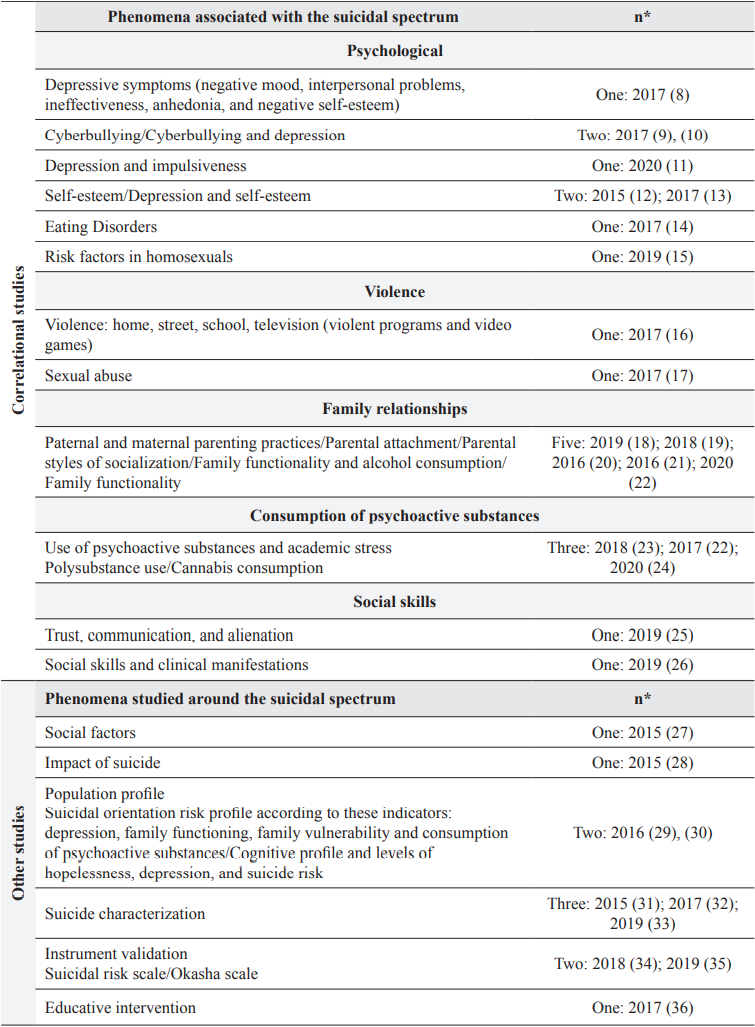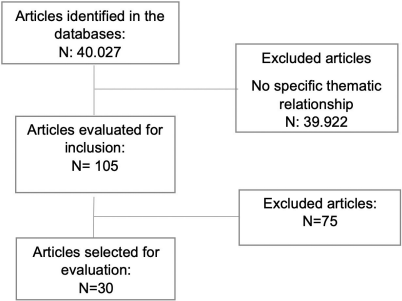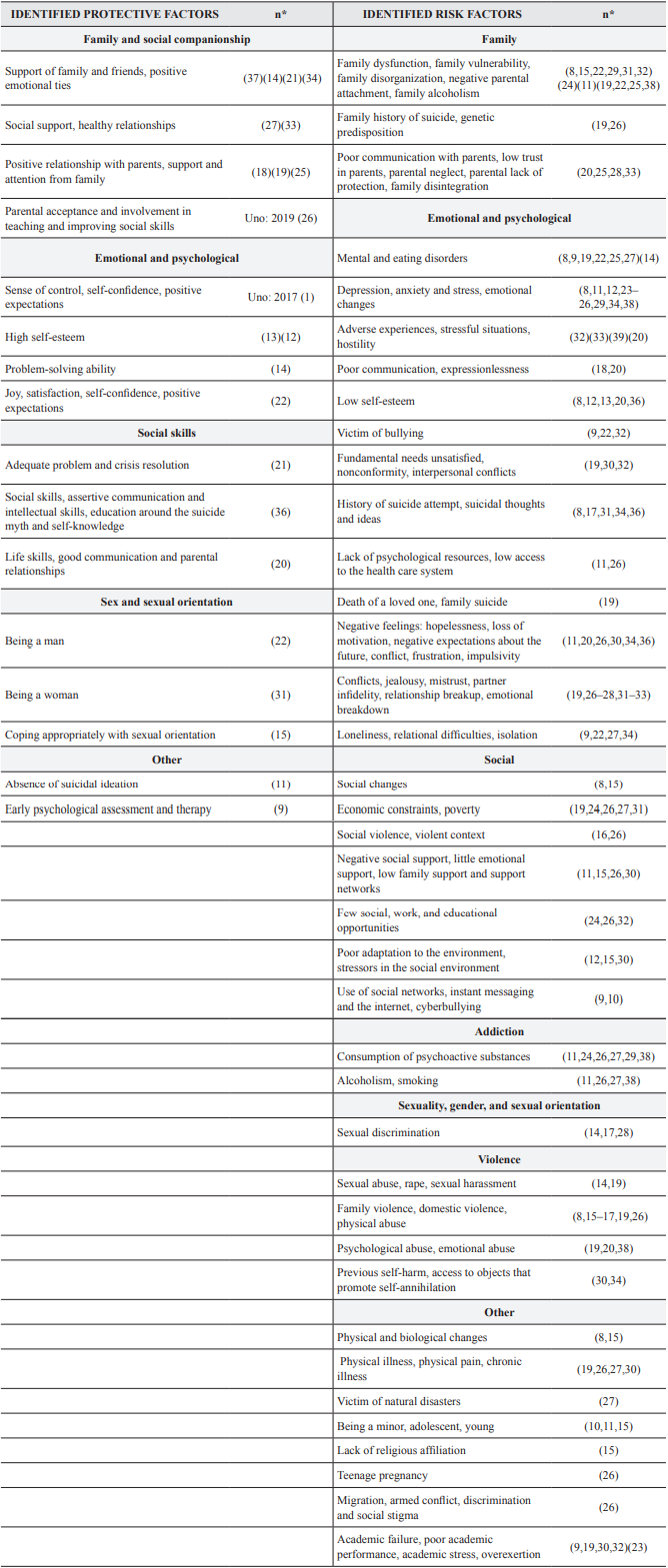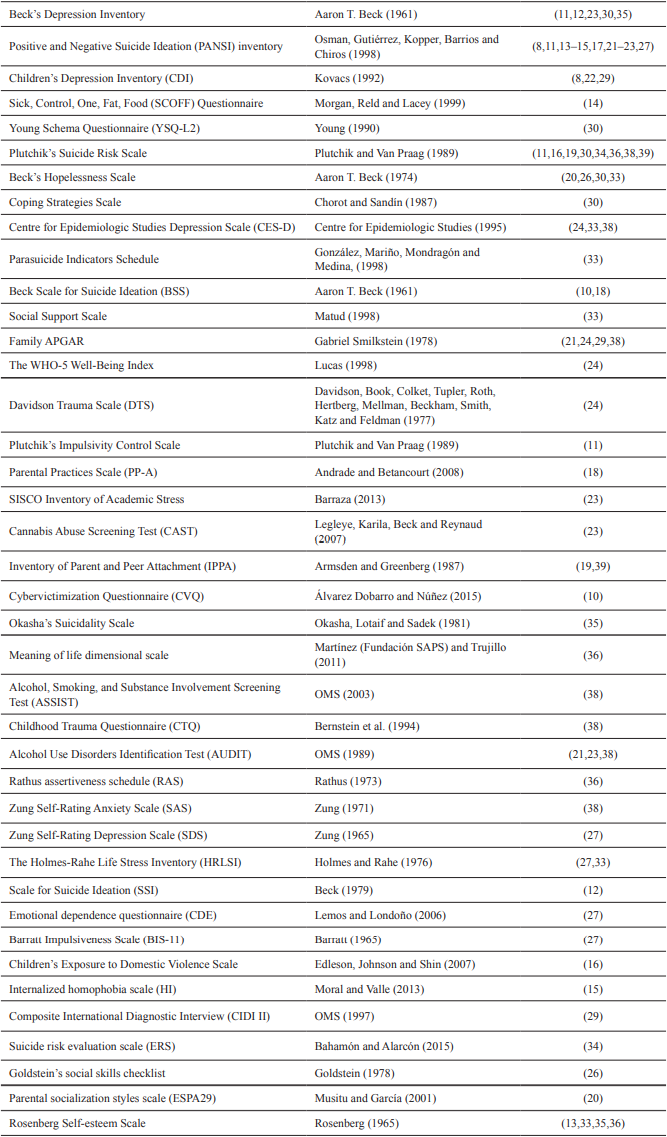Introduction
Around 800,000 deaths by suicide occur globally per year. A greater risk is evidenced in individuals with mental illnesses, chronic illnesses, suicidal behavior, alcoholism, low income, relationship breakups, and chronic pain, among others. There is also a high exposure factor in groups that are subject to discrimination, such as refugees, migrants, indigenous people, lesbian, gay, bisexual, transgender, transsexual, cross-dresser, intersex, queer (LGBTIQ) individuals, and prisoners. Indeed, suicide has become a public health problem and the young population has been one of the most affected by the phenomenon. By 2016, suicide was the second leading cause of death in people between 15 and 29 years of age, worldwide. According to the World Health Organization (WHO) 1, middle- and low-income nations are most at risk.
In Colombia, according to data from the Institute of Legal Medicine and Forensic Sciences, in recent years there has been a significant rise in the suicide rate. Studies say that from 4.5 per 100,000 inhabitants in 2009, the suicide rate rose to 5.93 in 2018, with an average of 2,083 cases per year. In 2018, the figure was higher with a total of 2,696 cases. The male population had the highest rate of consummated suicide with 82.34%, while in women the rate was 17.65%, which means an approximate ratio of 4 male per 1 female. Regarding the age groups for 2018, young people are the most affected, since the age group between 10-29 years represents 42% of the cases (1,130 suicides) 2.
Adolescence is a crucial stage of life when the greatest changes occur along with vulnerability and pressure. This child-adult transition is characterized by the acquisition of new responsibilities, the body changes typical of puberty, detachment from parents, the influence of friendships, and university admission. Risks to an adolescent’s mental health can also be generated by transitions marked by negative aspects such as family dysfunction, the influence of alcohol and drugs, social violence, sexual discrimination, a history of suicide by an acquaintance, and psychiatric disorders such as depression, anxiety, and stress -the main reasons for psychiatric consultation 3-5. Other circumstances that constitute a mental health risk include mental disorders, financial difficulties, substance abuse, alcohol consumption, family violence, and sexual abuse 6.
Reviewing the subject in more detail, suicide in adolescents and young adults is multifactorial, which makes it an even more complex phenomenon, since both biological and psychosocial elements are involved. Thus, it is relevant to analyze what happens in the young population and to identify their socio-demographic characteristics, social determinants, and the main causes and/ or exposure factors and protective factors. Concurrently, it is important to identify the consequences for families and communities and, for the failed suicide attempt, physical injuries, disabilities, and psychological damage to the person 7.
This implies that it is essential to examine the scientific research on suicide. International studies include those of Pablo Ezequiel Flores Kanter, a researcher who studied suicide in Argentina 6. In Mexico, Daniela Vázquez Vega et al. conducted an analysis on suicide between 1980-2014 and Luz Helena Buitrago León et al. carried out a bibliometric study of the scientific research published between 2008-2013 on children and adolescents with suicidal ideation.
Accordingly, it is necessary to undertake explorations of this type in Colombia. Therefore, this study aims to investigate the results of research on suicide in Colombian adolescents and young adults between 2015-2019. The study will generate key clues to apprehend and periodically monitor the figures and epidemiological characteristics of the phenomenon, which will reflect its behavior at the national level and then worldwide. Another benefit is that it reveals what the current research on suicide points to, as the subject is so complex that it encompasses all spheres of the human being. Finally, the study is of great relevance because it can guide plans, programs, and projects to improve health promotion and timely prevention based on scientific evidence.
Method
Documentary research was conducted with a qualitative, retrospective, cross-sectional approach of articles published between 2015- 2020 on suicide in Colombian adolescents and young adults. The search sources were databases such as Biblioteca Virtual en Salud, Pubmed, Scielo, and Google Scholar. The key terms were suicidal ideation, suicide, adolescents, young people, Colombia, Colombians, adolescents, suicides, young, among others, verified in the Descriptors in Health Sciences (DeCs) and Medical Subject Headings (MeSH) thesauri.
The following inclusion criteria were established: articles published between 2015-2020, indexed in scientific databases, and that address issues related to suicidal ideation, suicide attempt, and suicide in Colombian adolescents and young adults between 10-19 years old and 20-29 years old. Review articles, gray literature, articles comparing Colombia with other countries, and those where the full text was not available were excluded. Figure 1 shows the preliminary exploration.
To collect the information in the initial stage, an Excel database was built with the following variables: author, title, year, country, language, objective, methodology, main results, core conclusion, type of text, journal data, search strategy, format, date of consultation, reasons for inclusion and exclusion, and access link. Subsequently, the abstracts were reviewed, then the full text of the 30 included articles was read. For the analysis, summaries were written to facilitate the selection of information with the most relevant aspects of each of the articles and thus code the data according to certain preliminary categories. The research considered the ethical aspects outlined in Resolution 8430 of 1993 of the Colombian Ministry of Health, which establishes the scientific, technical, and administrative standards for health inquiries.
Results
This review found that, in Colombia, Psychology is the most involved field in studies on the suicidal spectrum with a percentage of 38%, followed by public health with 15%. Psychiatry and Epidemiology follow with 10% and 8% respectively, Statistics and Education sciences with 3% each, and then Family Medicine, Sociology, Occupational Therapy, Family Development, Anthropology, Philosophy, Nutrition, and General Medicine, each with 1.66%. It is worth mentioning that in none of the articles analyzed was Nursing found as an associated discipline.
Only one article addressed the relationship of suicidal behavior with school violence, which is striking. It should be noted that the main purpose of the study of the articles was to affirm or verify an association between a phenomenon and the presence of behavior from the suicidal spectrum and that main risk factors were mentioned, as observed in Table 1. Few writings focused on the educational area and the evaluation of the impact of suicide.
Table 1 Analysis of the central phenomena studied in the reviewed articles.

Source: Compiled by authors.
The data in Table 2 show that studies on protective factors are scarce, compared with those on risk factors. This shows that the research in Colombia is mainly aimed at risk awareness rather than looking for protective characteristics in adolescents and young adults.
The findings of this review of the Colombian context show that emotional ties and the support of family and friends are the most important protective factors, which demonstrates the role played by the family, healthy relationships, and support networks in the mental health of children, teenagers, and young adults. The existence of a research gap should be noted within such transcendental environments as school and university since that is where young people spend much of their time training and thinking about their future.
Regarding the risk factors for suicide (suicidal ideation, suicidal behavior, previous suicide attempt, and consummated suicide), family dysfunction and/or a problematic relationship with the family were the most important factors found in this search. Therefore, all disciplines should be involved in actions that strengthen the improvement of family ties. Those phenomena related to psychiatric and psychological disorders (depression, anxiety and stress, eating disorders), and especially those with a previously diagnosed mental disorder, should also be noted.
It is worth highlighting the currently emerging risk factors that have to do with the use of the Internet, since consumption in Colombia is high, especially in adolescents and young people. Hence, cyberbullying and the public exposure of private information on the web are beginning to have a leading role in recent studies.
As highlighted in Table 3, which was designed to show the instruments found during the review, the use of the Positive and Negative Suicidal Ideation Inventory (PANSI) predominates in the articles. Moreover, despite discussing the same country and the same populations in very similar conditions, around 40 different instruments are used, including tools for suicide risk, depression, anxiety, academic stress, and attachments, as well as instruments for family functionality and psychoactive substance abuse, each of which applies to the population studied.
Discussion
Nursing and mental health
The research carried out on the suicidal spectrum in the young population show that the predominant disciplinary approach is psychology. However, there are other important areas of knowledge for this field, such as Nursing. Galvis 40 asserts that, in the concrete approach to mental health, Nursing does not have the importance it deserves, since it has no presence in the published scientific literature.
Although all professions are valuable, the role of nurses is crucial for the management of a mentally ill person, since that role is supported by the establishment of diagnoses and the application of the nursing care process, all focused on the particularities presented by each person, family, and the community through primary health care actions. Guerra 41 confirms that Nursing has administrative, educational, investigative, and comprehensive care provision roles, given that it applies the biomedical assistance model but, at the same time, is based on concepts of its own corpus that help to provide complete care. This constitutes the main difference with other branches of knowledge.
According to Molina and Jara, the nursing professional has much to contribute and is formed with solid theoretical bases that are applied in practice 42. In this area, one could cite foundations such as Joyce Travelbee’s Human-to-Human Relationship Model, which states that the nurse must first understand the situation of the person, family, or group, and provide care based on this understanding. Likewise, in the context of Psychiatric Nursing, there is Phil Barker’s Tidal Model of mental health recovery. This paradigm proposes a philosophical approach that offers a different vision of life metaphorized as a journey in an ocean of experiences of constant flow in which the tides come and go. Here small changes can lead to big changes and there are storms in which the person must face the possibility of drowning. Other theories worth mentioning include Virginia Henderson’s Nursing Need Theory, based on 14 basic human needs, the Theory of Transpersonal Caring by Jean Watson, and the Self-Care Deficit Nursing Theory by Dorothea Orem. Each one of these theories offers multiple benefits when conducting research in this area.
Family and school environments
Nursing, in coordination with other professions, can implement holistic care processes in psychiatric patients to support dysfunctionalities or strengthen assets, since various phenomena are associated with the suicidal spectrum. Consistent with what was found in this study, Cañon Buitrago and Carmona Parra, in a study that included articles from different countries, mention that one of the most frequent reasons for the occurrence of these phenomena is interpersonal conflicts due to physical and psychological changes that an adolescent or young person goes through.
Among the phenomena is a significant increase in problems with parents, friends, or people in general 43.
Family functionality, or even partner functionality, is a key factor in increasing or decreasing suicidal ideas in a person. For example, when there are feelings of guilt about a certain act towards relatives or a spouse, when problems begin to increase in a family and intrafamily violence is evident, or when there is little communication between parents and children and lack of understanding, as a result, there is an increase in the number of mental illnesses, such as anxiety, depression, and ideas of self-harm and harm to others.
Similarly, in a study carried out in Mexico in 2015, the results showed that problems related to family members are one of the main causes of suicide attempts, including actions such as violence between parents, conflicts between siblings, and parental crises. Couple conflict is also mentioned, including separation, intimidation, and the terror experienced when living with a violent person. Despite these circumstances, individuals prefer to stay in this environment of constant threat than face the reality of feeling and living alone. This same document discusses difficulties in school, mainly difficulties with friends and classmates, which create environments of tension and misunderstanding 44. This is contrasted with the results of the present investigation, where the family and close environment stands out as influencing and determining agents of the suicidal spectrum.
The school environment comprises a scenario of social interaction where the physical and psychological changes must be considered, since bullying acts that generate negative emotions and stressful events are evident, and, in these situations, most adolescents do not have coping strategies. Therefore, a specific association is generated between the suicide attempt and school bullying, which can even include cyberbullying, harassment in which a person, after being deceived and sending intimate photos, begins to be extorted. The victim can experience feelings of loneliness, sadness, hopelessness, pessimism, and even manifest self-destructive ideas 43.
In the Colombian context, health care becomes complicated when considering the economic, geographical, and cultural barriers, among others. And it is unfortunate that a Colombian, especially an adolescent or a young person, cannot access timely mental health services, which should start with a consultation for the young person that many health institutions and health-promoting entities do not offer. This generates devastating effects, as sometimes they are the only means by which a young person can report their disease and receive optimal and timely treatment.
Protective factors and risk factors against the suicidal spectrum
The risk factors and protective factors for the suicidal spectrum found in the studies in Colombia are identified within the framework of three central dimensions: personal, family, and social. An analysis is important from two aspects: one is what puts mental health at risk-widely explored by the traditional approach-and the other is the protective aspect, an area in which there is little research. Galarza 45 and Soler et al. 46 emphasize the need to positively address mental health problems considering as a starting point the emotionality of adolescents (singularity), their social relationships, and their environments, through to the need for policies and multisectoral programs (macro), with the aim of overcoming the hegemonic predominance of risk.
The results of this review show the complexity of suicidal behavior, as it is influenced by many variables, including family, social, and psychological factors, that can prevent or exacerbate it and that determine how people envision their life in the future. It is here where Nursing has special relevance in the challenges of identifying elements of strength and the capacity of young people to face these situations that become stressful and are triggers for suicidal ideations and threats. Aaron Antonovsky raised the importance of analyzing the sense of coherence (SOC), a construct that expresses the degree to which people consider internal and external stimuli as positive, structured, and explainable, and which, therefore, helps them to see their life in a logical, manageable, and meaningful way 47-49.
Guevara et al. 50 state that SOC develops during the early stages of life (childhood, adolescence, and young adulthood) and changes only in the face of important situations that occur in the immediate and distant environment of the individual, where it becomes a protective factor against anxiety, stress, and depression, in addition to favoring optimism, strength, self-control, and coping capacity, all positive factors for the mental health of this population group 50. Thus, the SOC becomes a kind of meter that reflects the coping and resilience of young people in the face of stressful events and their association with the development of suicidal ideas and behaviors 51.
Aaron Antonovsky proposed the Orientation towards Life (OLQ) scale to measure the level of SOC in people from three cognitive domains: understandability, manageability, and significance 51. Different investigations have shown that this instrument can be used as a reliable tool to generate support and intervention actions that reinforce health and seek to prevent and minimize the consequences derived from negative behaviors present at an early age, such as suicidal ideation and attempts 51-56.
Finally, the review of the scientific evidence found that although there are multiple assessment scales for the phenomenon of suicide, all are focused on the diagnosis of risk, but no operative scales were found that are aimed at finding protective characteristics for suicide in the population studied. There are also no disciplinary instruments proper to Nursing for the assessment of adolescents and young adults that can detect suicidal risk in the Colombian context. Therefore, there is no distinct approach for adolescents or young people from the consideration of the particular local cultural conditions for comprehensive care through the nursing care process.
Conclusion
It is evident that one of the strongest disciplinary fields for addressing the suicidal spectrum is that of psychology. This becomes a challenge for Nursing both in academic training and in professional work. In Nursing, the idea is to provide adequate support and care for the patient throughout the entire process involving mental health, its prevention or its alteration.
Nursing staff, through their disciplinary knowledge and metaparadigm, consider people, environments, and care, which allows the detection of changes in young people and adolescents. It also makes it easier to identify the symptoms and the risks or how to strengthen weak dimensions considering the frequent phenomena found in the study.
According to the documents, research in this area in Colombia aims mainly to assess the risk rather than to look for those protective characteristics present in adolescents and young adults. Therefore, actions must be directed from a salutogenic approach. At the same time, although there are a large number of instruments for assessing mental health, it is necessary to go beyond instrumental views and carry out projects that involve praxis.

















